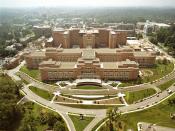The Scripps Research Institute, one of the country's largest, private, non-profit research organizations, has always stood at the forefront of basic biomedical science, a vital segment of medical research that seeks to comprehend the most fundamental processes of life. In just three decades the Institute has established a lengthy track record of major contributions to the betterment of health and the human condition.
The Institute has become internationally recognized for its basic research into immunology, molecular and cellular biology, chemistry, neurosciences, autoimmune diseases, cardiovascular diseases, virology and synthetic vaccine development. Particularly significant is the Institute's study of the basic structure and design of biological molecules; in this arena TSRI is among a handful of the world's leading centers.
The philosophy of The Scripps Research Institute emphasizes the creation of basic knowledge in the biosciences for the application of medical and material discoveries; the pursuit of fundamental scientific advances through interdisciplinary programs and collaborations, and the education and training of researchers preparing to meet the scientific challenges of the next century.
The bulk of the Institute's funding is derived from the National Institutes of Health and other federal agencies. In today's environment of increasing competition for shrinking federal dollars, however, collaborative industrial partnerships with leading pharmaceutical companies provide additional funding in several areas key to the organization's research objectives.
Currently housed in fourteen laboratory buildings with more than 1,000,000 square feet of space overlooking the Pacific, the Institute's staff includes more than 270 professors, 800 postdoctoral fellows, 1500 laboratory technicians, administrative and support personnel, and 126 Ph.D. students. The design of each facility, with a central galleria area ringed by laboratories and offices around its perimeter, is a tangible reflection of the value placed on multidisciplinary collaboration in traditional and emerging areas of science.
The Institute enjoys one of...


